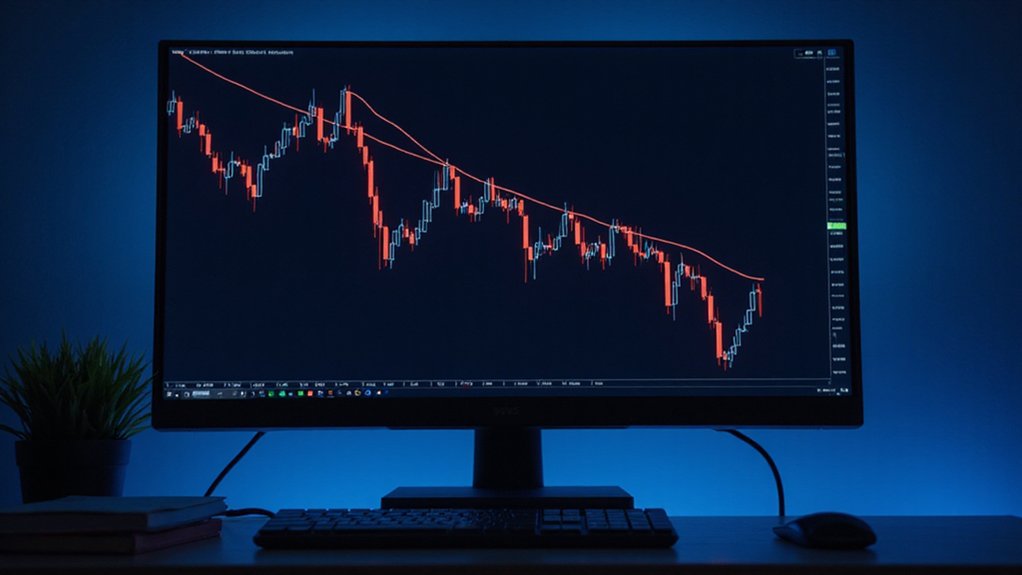A bear flag pattern represents technical analysis’s Cassandra, warning of continued downward price movement during established downtrends. Following a sharp initial decline (the flagpole), prices consolidate briefly in a countertrend channel (the flag) before inevitably breaking lower when bears regain control. Distinguished by declining volume during consolidation and increased selling upon breakdown, this formation offers traders precise profit targets—typically equal to the flagpole’s length. The pattern’s reliability makes it particularly valuable for those who understand market psychology’s predictable rhythms.

The bear flag pattern—that peculiar formation lurking in downtrending markets—represents one of technical analysis‘s most reliable harbingers of continued price decline.
This distinctive chart pattern emerges when a market takes a brief respite following a precipitous drop, allowing traders to discern the difference between temporary exhaustion and genuine trend reversal.
The pattern’s nomenclature derives from its visual resemblance to a flag on a pole, with the flagpole manifesting as a sharp, often panic-driven decline, while the subsequent flag forms as prices consolidate within parallel trendlines.
The anatomy of a bear flag begins with the flagpole—an almost vertical price descent typically triggered by substantial selling pressure or bearish catalysts.
This dramatic decline occurs amid elevated volume, signaling robust conviction among sellers.
Following this plummet, the market enters a consolidation phase characterized by a slight upward or sideways drift within a narrow channel.
During this interlude (the flag portion), volume typically attenuates as market participants reassess positions and temporarily equilibrate buying and selling interests.
The flag’s parallel boundaries frequently slope contrary to the prevailing downtrend, creating a deceptive impression of recovery that lures unwary bulls.
Confirmation arrives when price decisively breaches the flag’s lower trendline, accompanied by resurgent volume—the market’s way of announcing that bears have regained control after their momentary respite.
This breakout signals prudent entry for traders seeking to establish or augment short positions.
Risk management dictates positioning stop-loss orders just above the flag’s upper boundary, while profit targets can be calculated by measuring the flagpole’s length and projecting it downward from the breakout point.
While structurally identical to its bullish counterpart (merely inverted in direction), the bear flag inherently reflects continuing pessimism in market sentiment.
The pattern fundamentally represents an upside-down version of the bull flag, with the same technical significance but opposite directional implications.
Recognizing these patterns is especially valuable during extended bear markets, which are characterized by significant price decreases and negative investor sentiment.
For many crypto traders, the bear flag pattern offers clear entry points when looking to capitalize on continuing downward trends in digital assets.
Traders who recognize this pattern avoid the common pitfall of mistaking temporary consolidation for trend reversal.
In markets—as in nature—predators rarely announce their intentions, but the bear flag offers a rare glimpse into impending downside momentum.
Frequently Asked Questions
What Are the Success Rates of Bear Flag Patterns?
Bear flag patterns demonstrate a respectable 67-67.72% success rate in downtrends—a figure that, while impressive, should hardly inspire blind confidence in traders who’ve witnessed the market’s capacity for confounding expectations.
This reliability parallels their bullish counterparts but diminishes significantly in shorter timeframes.
Success rates fluctuate with market conditions (clear downtrends yielding better results) and trader expertise—a reminder that technical analysis remains as much art as science.
How Long Do Bear Flag Patterns Typically Last?
Bear flag patterns typically manifest as ephemeral consolidation phases, lasting from a few days to several weeks depending on the timeframe observed.
These briefer pauses in downtrends (hardly extended sabbaticals, mind you) tend toward the shorter end on intraday charts, while potentially stretching longer on daily or weekly timeframes.
Volume—that reliable harbinger of pattern development—characteristically diminishes during the consolidation before spiking at breakdown, a phenomenon that underscores these patterns’ fundamentally transient nature in broader market narratives.
Can Bear Flags Appear in Bullish Markets?
Bear flags rarely appear in bullish markets, as they’re inherently bearish continuation patterns.
When such formations do materialize during uptrends, they typically signal potential reversals rather than continuations—a curiosity that experienced traders approach with healthy skepticism.
These anomalous patterns require substantial confirmation from other indicators before action is warranted.
The market’s penchant for delivering exceptions to every rule remains one of its most reliable characteristics¹.
¹As previously discussed, context matters greatly when identifying technical patterns.
What Trading Volume Confirms a Valid Bear Flag?
Valid bear flag patterns exhibit distinctive volume characteristics throughout their formation.
Elevated volume during the initial flagpole confirms strong selling pressure, followed by notable volume contraction during consolidation—signaling diminished buying interest.
The critical confirmation comes during breakdown, when volume should substantially expand beyond consolidation averages (ideally approaching flagpole levels) within the first few candles.
Without this volume expansion at breakdown, traders face heightened risk of false signals and potential pattern failure.
How Do Bear Flags Differ From Bear Pennants?
Bear flags differ from bear pennants primarily in their shape characteristics.
While bear flags feature parallel trendlines forming a rectangular consolidation pattern that slopes against the previous downtrend, bear pennants display symmetrical triangles with converging trendlines that compress price toward an apex.
Pennants typically form over shorter timeframes than flags and exhibit tighter consolidation.
Both patterns serve as continuation signals in downtrends, with similar measured move objectives calculated using the preceding “flagpole” length before the consolidation began.









